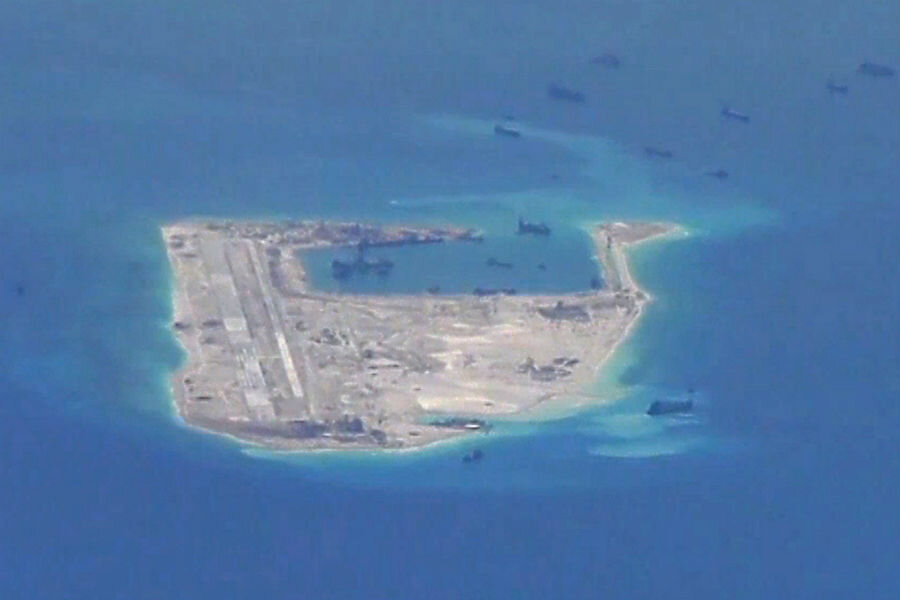China scrambles jets as US Navy tests navigation near disputed island
Loading...
| Beijing and Hong Kong
China scrambled fighter jets on Tuesday as a U.S. navy ship sailed close to a disputed reef in the South China Sea, a patrol China denounced as an illegal threat to peace which only went to show its defense installations in the area were necessary.
Guided missile destroyer the USS William P. Lawrence traveled within 12 nautical miles of Chinese-occupied Fiery Cross Reef, U.S. Defense Department spokesman, Bill Urban said.
The so-called freedom of navigation operation was undertaken to "challenge excessive maritime claims" by China, Taiwan, and Vietnam which were seeking to restrict navigation rights in the South China Sea, Urban said.
"These excessive maritime claims are inconsistent with international law as reflected in the Law of the Sea Convention in that they purport to restrict the navigation rights that the United States and all states are entitled to exercise," Urban said in an emailed statement.
China and the United States have traded accusations of militarizing the South China Sea as China undertakes large-scale land reclamations and construction on disputed features while the United States has increased its patrols and exercises.
Facilities on Fiery Cross Reef include a 3,000-meter (10,000-foot) runway which the United States worries China will use it to press its extensive territorial claims at the expense of weaker rivals.
China's Defence Ministry said two fighter jets were scrambled and three warships shadowed the U.S. ship, telling it to leave.
The U.S. patrol "again proves that China's construction of defensive facilities on the relevant reefs in the Nansha Islands is completely reasonable and totally necessary," it said, using China's name for the Spratly Islands where much of its reclamation work is taking place.
Foreign Ministry spokesman Lu Kang said the U.S. ship illegally entered Chinese waters.
"This action by the U.S. side threatened China's sovereignty and security interests, endangered the staff and facilities on the reef, and damaged regional peace and stability," he told a daily news briefing.
SENSITIVE AREA
China claims most of the South China Sea, through which $5 trillion in ship-borne trade passes every year. The Philippines, Vietnam, Malaysia, Taiwan and Brunei have overlapping claims.
The Pentagon last month called on China to reaffirm it has no plans to deploy military aircraft in the Spratly Islands after China used a military plane to evacuate sick workers from Fiery Cross.
"Fiery Cross is sensitive because it is presumed to be the future hub of Chinese military operations in the South China Sea, given its already extensive infrastructure, including its large and deep port and 3000-meter runway," said Ian Storey, a South China Sea expert at Singapore's ISEAS Yusof Ishak Institute.
"The timing is interesting, too. It is a show of U.S. determination ahead of President Obama's trip to Vietnam later this month."
Speaking in Vietnam, Daniel Russel, assistant secretary of state for East Asia and the Pacific, said freedom of navigation operations were important for smaller nations.
"If the world's most powerful navy cannot sail where international law permits, then what happens to the ships of navy of smaller countries?," Russel told reporters before news of the operation was made public.
China has reacted with anger to previous U.S. freedom of navigation operations, including the overflight of fighter planes near the disputed Scarborough Shoal last month, and when long-range U.S. bombers flew near Chinese facilities under construction on Cuarteron Reef in the Spratlys last November.
U.S. naval officials believe China has plans to start reclamation and construction activities on Scarborough Shoal, which sits further north of the Spratlys within the Philippines claimed 200 nautical mile (370 km) exclusive economic zone.
A tough-talking city mayor, Rodrigo Duterte, looks set to become president of the Philippines after an election on Monday. He has proposed multilateral talks on the South China Sea.
A Chinese diplomat warned last week that criticism of China over the South China Sea would rebound like a coiled spring.
The Associated Press reports that China's navy has launched annual war drills in the South China Sea with one of its most advanced warships, the missile destroyer Hefei.
The exercises include simulations for breaking an enemy blockade and reconnaissance drills with submarine forces. Five other guided-missile destroyers, a frigate and a supply ship of the South Sea Fleet based in Sanya on Hainan Island, home to a major naval and air force base, are taking part.
According to the official Xinhua News Agency, the ships will be joined by forces based in the Spratly and Paracel islands, where China has embarked on massive island-building to expand and reinforce the reefs it controls in the disputed region.
Also last week, China sent famed singer of patriotic anthems Song Zuying on a tour of its man-made islands in the Spratlys to entertain troops and underscore confidence in asserting its claim in the contested area.
Among the songs performed: "Ode to the South Sea Defenders," whose lyrics speak of "troops of stout men with guns in their hands who battle the wind and fight the waves to guard the nation's door."
Photos of the performances also offered a rare glimpse of the extensive work China has been carrying out at Fiery Cross Reef, showing lighthouses, harbors and buildings. In the background of some can be seen one of the navy's massive Type 071 amphibious dock ships, capable of carrying four helicopters and as many as 800 troops.
(Additional reporting by David Brunnstrom in Paris and My Pham in Hanoi; Writing by Ben Blanchard; Editing by Lincoln Feast, Robert Birsel)





